Ignorance is Bliss
BY GUEST BLOGGER | June 30, 2015
written by: Mary Ramatici, JVC Albuquerque ’14-’15
Before moving to Albuquerque, I lived in California for 21 years. A border state where the influence of Mexico is greatly present and the topic of immigration is a common point of conversation. I grew up seeing Mexican men standing outside gas stations looking for work. I knew people who came from Mexico, never really knowing the status of their citizenship but not really thinking to ask them. I even took Spanish classes knowing that in the years to come, Spanish will be the number one most spoken language in California. I thought I was well educated on the topic of immigration, but after my trip with JVC to the Arizona/Mexico border, it turns out that, in fact, I was pretty ignorant. I was only choosing certain things to know, but not fully understanding the harsh realities and experiences that many migrants go through on a daily basis. Fortunately, this trip allowed me the chance to hear the stories first-hand and meet migrants who have been deported.
Before continuing, I want you to imagine this: You have just been dropped off by a United States detention center bus at the entrance of Mexico. You are told to continue walking straight but to veer toward the right, where there is a caged sidewalk. You do as you are told by the border patrol. You are now walking in this caged sidewalk and you look to your left. On your left there is an American walking the same path as you, however they are not in a cage and they are walking freely toward Mexico to do some sightseeing and tourist shopping for the day. You think to yourself, how excited and carefree they seem.
You are a middle-aged Mexican citizen who has a loving partner and two children in the United States. You have been caught trying to cross the border to reunite with your family, and you have been detained and deported. As you continue walking through the cage toward Mexico, you look behind you: there is the United States. You had come so close to freedom, to your family, to a better life. You look forward and you see Mexico, a place that once was home but now only represents loss and despair.
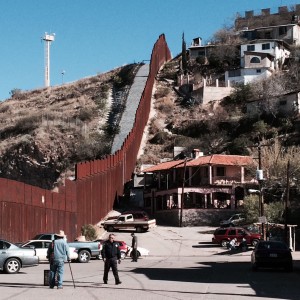
“The Caged Sidewalk”
I wish the caged sidewalk were a figment of my imagination, something I made up for the dramatization of my story. However, the caged sidewalk exists. The United States recently built it in hopes of streamlining the deportation of migrants who have tried to cross the border. The caged sidewalk reminded me of something someone puts an animal in to contain and control. I’m sure this never crossed the United States government’s mind. The caged sidewalk was one of my first impressions of the border. My second impression was the monstrous wall that separates the United States and Mexico. The wall itself is just plain ugly—there is nothing aesthetically pleasing about it. Plus, it is insanely tall. It has slivers through it, just enough space to see what’s on the other side. I learned that there are only two other border walls that exist in the world. The first is the wall between Palestine and Israel. The second wall is the one that separates North Korea and South Korea. What interesting company we are keeping.
After crossing the border and arriving in Mexico, the Albuquerque and Tucson communities visited the Comedor. The Comedor is a day shelter that serves two meals a day to migrants who have been deported. The Comedor is part of the Kino Border Initiative (KBI) which is a binational organization that works in the area of migration and is located in both Nogales, Arizona and Nogales, Mexico. Its mission is to “promote U.S./Mexico border and immigration policies that affirm the dignity of the human person and a spirit of bi-national solidarity.” Before serving the meal, there are presentations on human rights, the different services that are provided, and the other organizations there, like “No More Deaths.” Being in the shelter was very eye-opening. It was sad knowing the people we were serving were newly deported and probably had experienced trauma when crossing the border. While there, I was
fortunate enough to hear some of these stories. I was talking with one woman who told me that she and her husband had been traveling for seven months. They started in Honduras and ended up in Nogales. So close, yet so far away. Even though language did cause some barriers, the nonverbal communication was powerful. When talking to the woman, I could see sadness and defeat in her eyes. She sat, shoulders slouched and frail. This was just one of the many stories of the migrants who use the Comedor services.
After our time at the Comedor, we headed to the women’s overnight shelter, which is also part of KBI. The shelter is two rooms in an apartment complex. It houses eight women, including two nuns who are there to support and supervise the migrant women. While there, we met Candelaria. She arrived at the shelter the day before and wanted to share her story with us. Candelaria lived in the United States with her husband and children for 12 years. A few months ago, she received news that her mother was sick and she wanted Candelaria to come back to Mexico to visit her. Candelaria did as she was told and went back to Mexico. Once back, she found out that the money she and her husband had been continuously sending back to their family members was nowhere to be found. When Candelaria decided to leave and come back to the United States, she found that it was not so easy. She has tried three times. Her first time she crossed in Texas, and involved swimming across a river. While crossing, border patrol caught sight of her and started chasing her. She had to turn around and hide in a local shop near the river. The second attempt consisted of her walking across the border, assuming no one was paying attention to her. That was unsuccessful and she was caught. Her third and latest attempt involved her using someone else’s papers. Again, she was caught and this time detained. She had just returned from being in the detention center for 90 days. Candelaria was defeated. Everyone in the room could tell. When asked what she has planned to do next, she answered, “I don’t know. Maybe go to Cancun in search of a job or start a life here in Nogales.” Her answer did not include trying to cross the border again, nor did it include her being reunited with her loved ones in the United States. Her reality is so many people’s nightmare: separated from loved ones and no way of being reconnected any time soon.
The next day, we met with a representative from Samaritans. Samaritans is an organization that has people walk the migrant trails weekly in search of migrants who have crossed the border and are in need of help. This help may include emergency and humanitarian aid. They also leave care packages of water, food, and socks at the border for those who are crossing. We were able to walk that 8-mile trail and experience the terrain and weather that most migrants face during this time of year. The trail was very rocky and extremely uneven, making it easy to form blisters on our feet or sprain or break ankles. Luckily for us, the weather was not too hot and we were able to have a cool breeze every once in a while, something very uncommon in the hot Arizona desert.
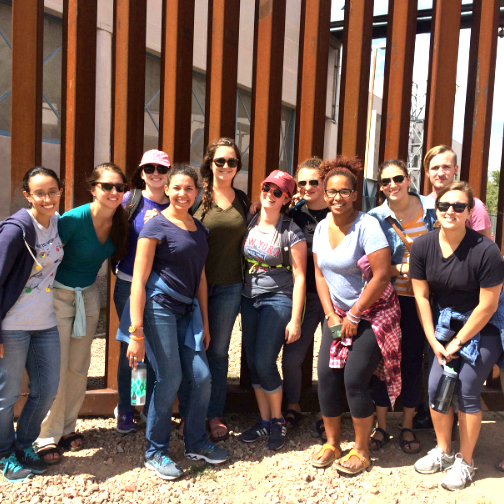
The Jesuit Volunteers at the Border Fence
This time when we arrived at the border, I had a very different impression. This time the border was not a huge wall. Instead, it was a barbed-wire fence with a hole big enough for a person to squeeze through. We left our care packages there at the border and headed back to the car, all of us knowing that our walk was n
thing compared to the reality that many migrants face. At the end of our walk, we will take a nice warm shower, eat delicious food, and sleep on a comfortable bed. For the migrants, making it this far is just the start for them. They may have made it across the border and into the United States, but now they must walk to the nearest town, which is still many more miles away. They must start a new life while still living in fear of being caught by the U.S. government.
Ignorance might be bliss, but is it really worth it? Knowing what I know now only makes me want to further my education on this topic. Before this trip, I never felt confident talking about immigration. Now I have experience and stories that I can share. I experienced a lot on this trip. The first day, I was able to experience the day-to-day challenges many migrants go through. I was able to experience this by their story-telling and the emotions they shared with me. The second day, I was able to experience the trails the migrants use to cross the border and enter the United States. Experiences are powerful and something no one can take away from you. It is something that is special to you and belongs only to you. This trip was an experience of a lifetime and something I will never forget.
ISN welcomes faith & justice related blog submissions from members of the Ignatian family. Please let us know of any blog ideas or posts using this form: ISN Blog Ideas

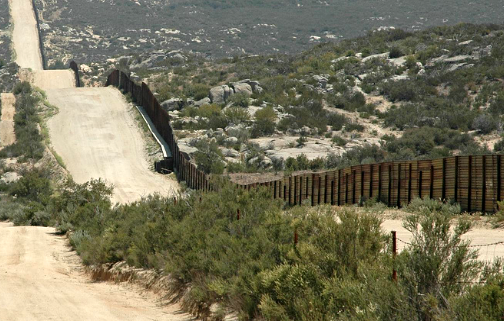


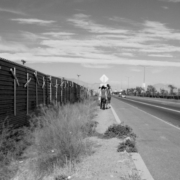
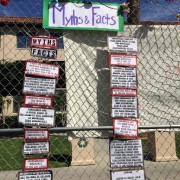




Leave a Reply
Want to join the discussion?Feel free to contribute!